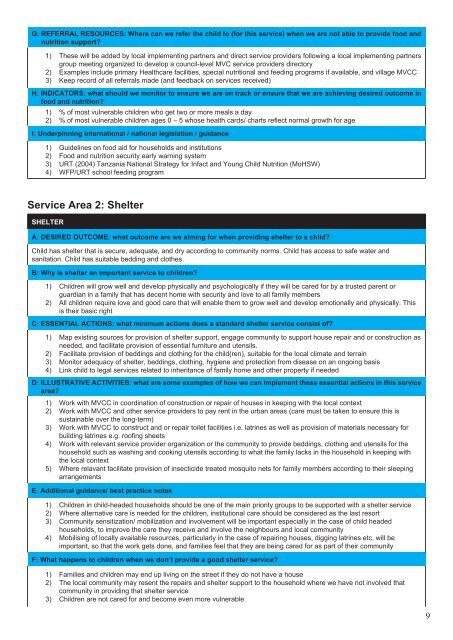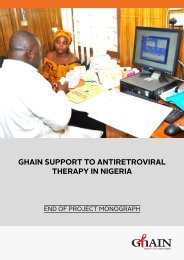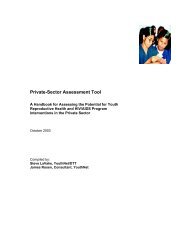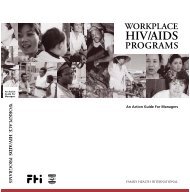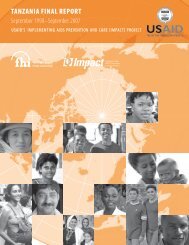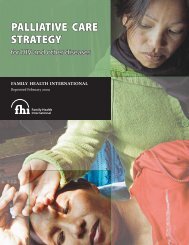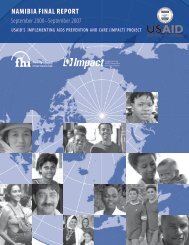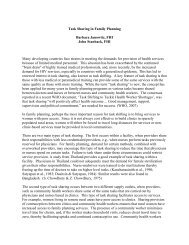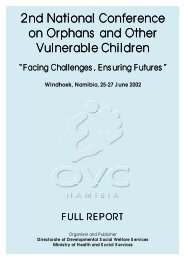National Guidelines for Improving Quality of Care, Support ... - FHI 360
National Guidelines for Improving Quality of Care, Support ... - FHI 360
National Guidelines for Improving Quality of Care, Support ... - FHI 360
You also want an ePaper? Increase the reach of your titles
YUMPU automatically turns print PDFs into web optimized ePapers that Google loves.
G: REFERRAL RESOURCES: Where can we refer the child to (<strong>for</strong> this service) when we are not able to provide food and<br />
nutrition support?<br />
1)<br />
2)<br />
3)<br />
These will be added by local implementing partners and direct service providers following a local implementing partners<br />
group meeting organized to develop a council-level MVC service providers directory<br />
Examples include primary Healthcare facilities, special nutritional and feeding programs if available, and village MVCC<br />
Keep record <strong>of</strong> all referrals made (and feedback on services received)<br />
H: INDICATORS: what should we monitor to ensure we are on track or ensure that we are achieving desired outcome in<br />
food and nutrition?<br />
1)<br />
2)<br />
% <strong>of</strong> most vulnerable children who get two or more meals a day<br />
% <strong>of</strong> most vulnerable children ages 0 – 5 whose health cards/ charts reflect normal growth <strong>for</strong> age<br />
I: Underpinning international / national legislation / guidance<br />
1)<br />
2)<br />
3)<br />
4)<br />
<strong>Guidelines</strong> on food aid <strong>for</strong> households and institutions<br />
Food and nutrition security early warning system<br />
URT (2004) Tanzania <strong>National</strong> Strategy <strong>for</strong> Infact and Young Child Nutrition (MoHSW)<br />
WFP/URT school feeding program<br />
Service Area 2: Shelter<br />
SHELTER<br />
A: DESIRED OUTCOME: what outcome are we aiming <strong>for</strong> when providing shelter to a child?<br />
Child has shelter that is secure, adequate, and dry according to community norms. Child has access to safe water and<br />
sanitation. Child has suitable bedding and clothes.<br />
B: Why is shelter an important service to children?<br />
1)<br />
2)<br />
Children will grow well and develop physically and psychologically if they will be cared <strong>for</strong> by a trusted parent or<br />
guardian in a family that has decent home with security and love to all family members<br />
All children require love and good care that will enable them to grow well and develop emotionally and physically. This<br />
is their basic right<br />
C: ESSENTIAL ACTIONS: what minimum actions does a standard shelter service consist <strong>of</strong>?<br />
1)<br />
2)<br />
3)<br />
4)<br />
Map existing sources <strong>for</strong> provision <strong>of</strong> shelter support, engage community to support house repair and or construction as<br />
needed, and facilitate provision <strong>of</strong> essential furniture and utensils.<br />
Facilitate provision <strong>of</strong> beddings and clothing <strong>for</strong> the child(ren), suitable <strong>for</strong> the local climate and terrain<br />
Monitor adequacy <strong>of</strong> shelter, beddings, clothing, hygiene and protection from disease on an ongoing basis<br />
Link child to legal services related to inheritance <strong>of</strong> family home and other property if needed<br />
D: ILLUSTRATIVE ACTIVITIES: what are some examples <strong>of</strong> how we can implement these essential actions in this service<br />
area?<br />
1)<br />
2)<br />
3)<br />
4)<br />
5)<br />
Work with MVCC in coordination <strong>of</strong> construction or repair <strong>of</strong> houses in keeping with the local context<br />
Work with MVCC and other service providers to pay rent in the urban areas (care must be taken to ensure this is<br />
sustainable over the long-term)<br />
Work with MVCC to construct and or repair toilet facilities i.e. latrines as well as provision <strong>of</strong> materials necessary <strong>for</strong><br />
building latrines e.g. ro<strong>of</strong>ing sheets<br />
Work with relevant service provider organization or the community to provide beddings, clothing and utensils <strong>for</strong> the<br />
household such as washing and cooking utensils according to what the family lacks in the household in keeping with<br />
the local context<br />
Where relavant facilitate provision <strong>of</strong> insecticide treated mosquito nets <strong>for</strong> family members according to their sleeping<br />
arrangements<br />
E: Additional guidance/ best practice notes<br />
1)<br />
2)<br />
3)<br />
4)<br />
Children in child-headed households should be one <strong>of</strong> the main priority groups to be supported with a shelter service<br />
Where alternative care is needed <strong>for</strong> the children, institutional care should be considered as the last resort<br />
Community sensitization/ mobilization and involvement will be important especially in the case <strong>of</strong> child headed<br />
households, to improve the care they receive and involve the neighbours and local community<br />
Mobilising <strong>of</strong> locally available resources, particularly in the case <strong>of</strong> repairing houses, digging latrines etc. will be<br />
important, so that the work gets done, and families feel that they are being cared <strong>for</strong> as part <strong>of</strong> their community<br />
F: What happens to children when we don’t provide a good shelter service?<br />
1) Families and children may end up living on the street if they do not have a house<br />
2) The local community may resent the repairs and shelter support to the household where we have not involved that<br />
community in providing that shelter service<br />
3)<br />
Children are not cared <strong>for</strong> and become even more vulnerable<br />
9


